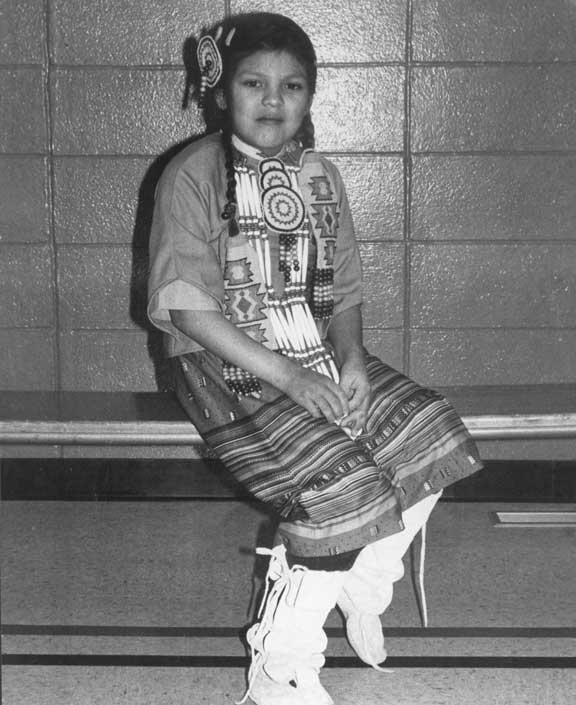|
The Anicinabe |
|
 |
|
|
Carlyle, 1980, Standingready |
|
| FTLComm - Tisdale - March 22, 2001 | |
| When the French Explorers made their way up the St. Lawrrence they were confronted with a completely inhabited country. Five nations occupied the land they were exploring and were neatly organised into alliances with each other. The Europeans were there to invade the land and considered the inhabitants as inferior spear chuckers and were soon embroiled in a very nasty war for territory. | |
| The invaders simply had no yard stick to measure what they encountered, the people they saw were both hunters and farmers but they were not Christians and in a Europe filled with religious zeal non-Christians were to be destroyed or converted. | |
| We as a country are a very long way from understanding the significance and advanced nature of the democratically government and culturally developed people who were already in possession of the continent. The odd thing is that the modern day prodigy of these people have through a systematic process of assimilation pretty much lost awareness of their culture as well. | |
| From Ontario, across Manitoba and into Eastern Saskatchewan are the Anicinabe. They were called Ojibwa as part of the Five Nations and the fur traders referred to them as Saulteaux. For a time they referred to themselves as Ojibwa but today the preferred name is the Anicinabe. | |
| What is important for everyone to understand is that North American aboriginal people are as diverse from one another as all other peoples on the planet. Their cultures come from more than one source in the past and every single language group in Canada with the exception of the Metis are at least ten times older since their origin than the European invaders. They were technologically adapted perfectly for the land in which they lived and it was their lack of coehesivenss due to their extreme diversity which prevented them from successfully repelling the invasion. | |
| The Anicinabe people are the majority of the people on Carlyle's Whitebear reserve. The family names Standingready almost is synomous with leadership. The reserves near Kamsack and Pelly are also Anicinabe, as is Kinistin South of Tisdale. The reserves along the Qu Appelle chain consist mostly of Anicinabe but also have a number of Cree and a few Nakota. | |
| Here is what is really interesting about this group of people. Recent DNA work is suggesting taht this language group are not likely to be related to Asian people like most modern day North American aboriginal people. Strong evidence suggests that somewhere in antiquity the Anicinabe, the people who like to live in wood houses came to North America from Europe by boat. | |
| The Anicinabe have some remarkable cultural traditions. These are not always present and these comments could be taken as stereotypes but please take them only to be a rough description of some of the observable traits of a typical Anicinabe people are. My experience as a principal of young modern Anicinabe is that they take the process of selecting a mate very seriously and the selection process is one carried out by the young women. They will engage in serious violence in contest for a desirable partner and my experience is that young Anicinabe males are remarkably proud of their children and take an active part in raising them even if the relationship with the mother ends. | |
| One very distinctive thing about the modern form the Anicinabe culture takes is that there is a strong sense of people knowing their place and behaving appropriate to their social status. A person who is defiant or challenges the status quo is said to be "cheeky" and almost all school yard fights will come down to "he/she was getting cheeky with me". Honour and self esteem are big issues among the Anicinabe and they suffered considerably from the residential school process. | |
| Phil Fontaine a former leader of all Canadian aboriginal people tells with considerable sadness of the harsh treatment and the cultural genocide practiced in the schools which attacked their language culture and foundation as a people. | |
| The Anicinabe still can trace their roots to the ancient clan system. You might get confused if you think of Anicinabe clans like those of the Scotts because the Scott clans are actually blood relative relationships. Anicinabe clans, similar to those found on the West Coast are instead social and cultural afinity groups. In a way you might think of these clans as similar to modern business service clubs, like the Elks or Lions but instead of joining then club you were born into the clan. With time knowledge of these clans is fading but it is still within living memory. | |
| By Timothy W. Shire | |
Timothy Shire service as vice Principal in Carlyle, counsellor at the Cowessess Education Centre and principal at Fort Alexandre (near Pine Falls Manitoba) |
|